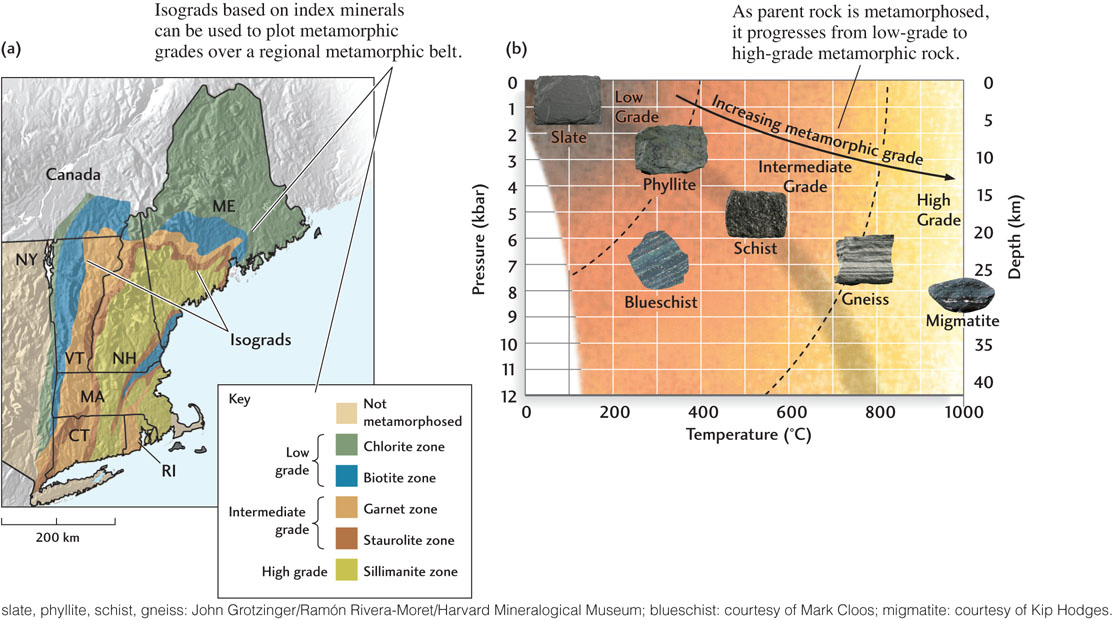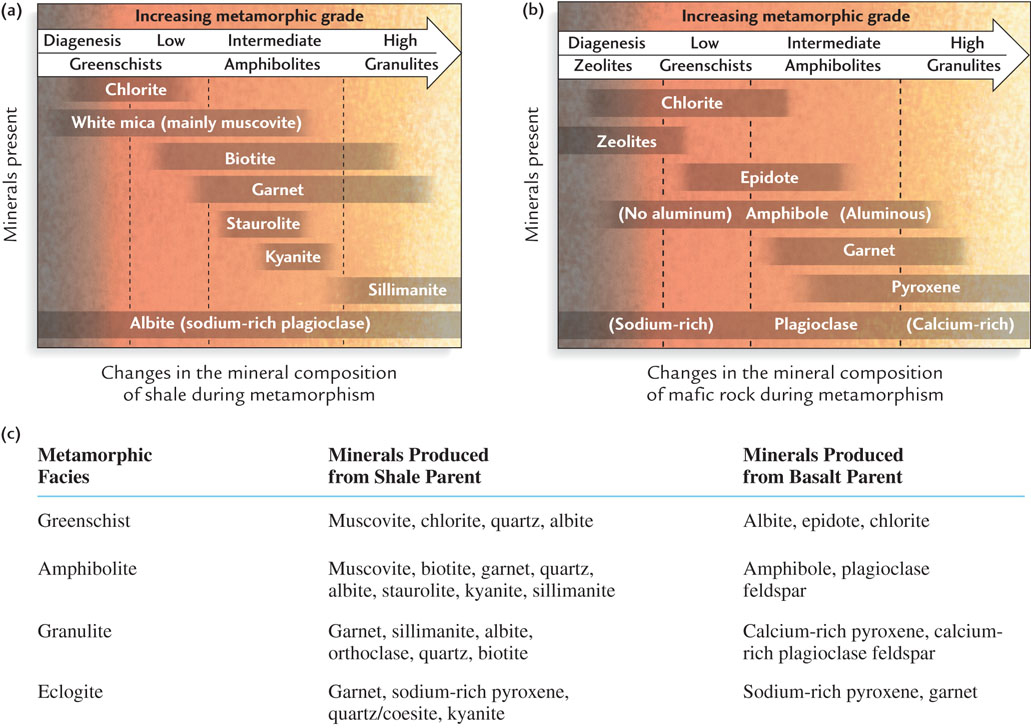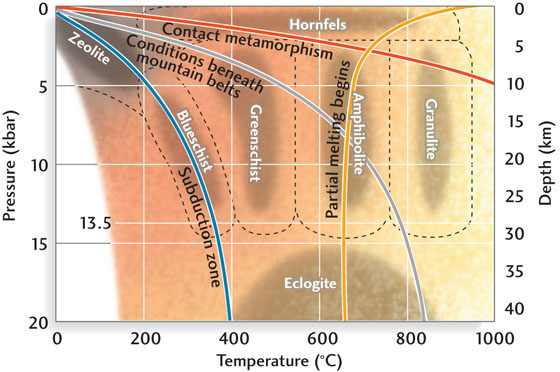Regional Metamorphism and Metamorphic Grade
As we have seen, metamorphic rocks form under a wide range of conditions, and their mineralogies and textures are clues to the pressures and temperatures in the crust where and when they formed. Geologists who study the formation of metamorphic rocks constantly seek to determine the intensity and character of metamorphism more precisely than is indicated by a designation of “low grade” or “high grade.” To make these finer distinctions, geologists “read” minerals as though they were pressure gauges and thermometers. These techniques are best illustrated by their application to regional metamorphism.
Mineral Isograds: Mapping Zones of Change
When we study a broad belt of regional metamorphism, we can see many outcrops, some showing one set of minerals, some showing others. Different zones within the belt may be distinguished by index minerals: abundant minerals that each form under a limited range of temperatures and pressures (Figure 6.9). For example, a zone of unmetamorphosed shales may lie next to a zone of weakly metamorphosed slates (Figure 6.9a). As we move from the shale zone into the slate zone, a new mineral—chlorite—appears. Chlorite is an index mineral marking the point at which we move into a new zone with a higher metamorphic grade. If laboratory studies have determined the temperature and pressure at which the index mineral forms, we can draw conclusions about the conditions that existed when the rocks in the zone were formed.

We can use the occurrences of index minerals to make a map of the boundaries between metamorphic zones. Geologists define these boundaries by drawing lines called isograds that plot the transitions from one zone to the next. Isograds are used in Figure 6.9a to show a series of mineral assemblages produced by the regional metamorphism of shale in New England. A pattern of isograds tends to follow the deformation features (folds and faults) of a region. An isograd based on a single index mineral, such as the chlorite isograd in Figure 6.9a, provides a good approximate measure of metamorphic pressure and temperature.
To determine metamorphic pressure and temperature more precisely, geologists can examine a group of two or three minerals that have crystallized together. For example, based on laboratory data, a geologist knows that a sillimanite zone that contains orthoclase feldspar and sillimanite must have formed by the reaction of muscovite and quartz at temperatures of about 600°C and pressures of about 5 kbar, liberating water (as water vapor) in the process. The sillimanite isograd records the following reaction:
160

Because isograds reflect the pressures and temperatures at which the minerals in a regional metamorphic belt formed, the isograd sequence in one belt may differ from that in another. The reason for this variation is that, as we have seen, pressures and temperatures do not increase at the same rate in all plate tectonic settings.
Metamorphic Grade and Parent Rock Composition
The kind of metamorphic rock that results from a given grade of metamorphism depends partly on the mineralogy of the parent rock (Figure 6.10). The metamorphism of shale, as shown in Figure 6.9a, reveals the effects of pressure and temperature on parent rock that is rich in clay minerals, quartz, and perhaps some carbonate minerals. The metamorphism of mafic volcanic rock, composed predominantly of feldspars and pyroxene, follows a different course (Figure 6.10b).

In the regional metamorphism of a basalt, for example, the lowest-grade rocks characteristically contain various zeolite minerals. The silicate minerals in the zeolite class contain water within their crystal structure. Zeolite minerals form at very low temperatures and pressures. Rocks that include this group of minerals are thus placed in the zeolite grade.
Overlapping with the zeolite grade is a higher grade of metamorphosed mafic volcanic rocks, the greenschists, whose abundant minerals include chlorite. Next are the amphibolites, which contain large amounts of amphiboles. The granulites, coarse-grained rocks containing pyroxene and calcium-rich plagioclase, constitute the highest grade of metamorphosed mafic volcanic rocks.
Rocks of the greenschist, amphibolite, and granulite grades are also formed during metamorphism of sedimentary rocks such as shale, as shown in Figure 6.10b. The pyroxene-bearing granulites are the products of high-grade metamorphism in which the temperature is high and the pressure is moderate. The opposite conditions, in which the pressure is high and the temperature moderate, produce rocks of the blueschist grade from parent rock of various starting compositions, from mafic volcanic rocks to shaley sedimentary rocks (see Figure 6.9b). The name comes from the abundance of glaucophane, a blue amphibole, in these rocks. Still another metamorphic rock, formed at extremely high pressures and moderate to high temperatures, is eclogite, which is rich in garnet and pyroxene.
161
Metamorphic Facies
We can plot this information about the grades of the metamorphic rocks in a regional metamorphic belt—derived from parent rocks of many different chemical compositions—on a graph of temperature and pressure (Figure 6.11). Metamorphic facies are groupings of rocks of various mineral compositions formed under particular conditions of temperature and pressure from different parent rocks. By delineating metamorphic facies, we can be more specific about the grades of metamorphism observed in rocks. Two essential points characterize the concept of metamorphic facies:
- 1. Different kinds of metamorphic rocks of the same metamorphic grade form from parent rocks of different composition.
- 2. Different kinds of metamorphic rocks of different metamorphic grades form from parent rocks of the same composition.

Figure 6.10c shows the major minerals of the metamorphic facies produced from shale and basalt. Because parent rocks vary so greatly in composition, there are no sharp boundaries between metamorphic facies (see Figure 6.11). Perhaps the most important reason for analyzing metamorphic facies is that they give us clues to the plate tectonic processes responsible for metamorphism, as we shall see next.
162